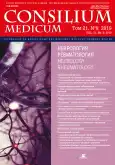CLINICAL PORTRAITS OF “TYPICAL” PATIENTS IN THE PRACTICE OF A NEUROLOGIST
- Authors: Ekusheva E.V.1,2
-
Affiliations:
- Federal Research Center for Specialized Types of Medical Assistance and Medical Technologies
- Wayne Clinic of Headache and Autonomic Disorders
- Issue: Vol 21, No 9 (2019)
- Pages: 131-135
- Section: Articles
- URL: https://journals.rcsi.science/2075-1753/article/view/95337
- DOI: https://doi.org/10.26442/20751753.2019.9.190646
- ID: 95337
Cite item
Full Text
Abstract
Full Text
##article.viewOnOriginalSite##About the authors
Eugenia V. Ekusheva
Federal Research Center for Specialized Types of Medical Assistance and Medical Technologies; Wayne Clinic of Headache and Autonomic Disorders
Email: ekushevaev@mail.ru
д-р мед. наук, проф., зав. каф. нервных болезней Академии постдипломного образования ФГБУ ФНКЦ, Клиника головной боли и вегетативных расстройств им. акад. А.М. Вейна Москва, Россия
References
- Atkinson JH. Chronic back pain: searching for causes and cures. J Rheumatol 2004; 31: 2323-5.
- Global, regional, and national incidence, prevalence, and years lived with disability for 328 diseases and injuries for 195 countries, 1990-2016: a systematic analysis for the Global Burden of Disease Study 2016. Lancet Neurol 2017; 390: 1211-859.
- Shmagel A, Foley R, Ibrahim H. Epidemiology of chronic low back pain in US adults: data from the 2009-2010 National Health and Nutrition Examination Survey. Arthritis Care Res (Hoboken) 2016; 68 (11): 1688-94.
- Schmidt C, Raspe H, Pfingsten M et al. Back pain in the German adult population: prevalence, severity, and sociodemographic correlates in a multiregional survey. Spine 2007; 32 (18): 2005-11.
- Tavee JO, Levin KH. Low Back Pain. Continuum (Minneap Minn) 2017; 23 (2): 467-86.
- Исайкин А.И., Шевцова Г.Е., Рожков Д.О. и др. Роль мышечного фактора в развитии поясничной боли. Неврология, нейропсихиатрия,психосоматика.2017;9 (2): 95-101. [Isaikin A.I., Shevtsova G.E., Rozhkov D.O. et al. Rol' myshechnogo faktora v razvitii poiasnichnoi boli. Nevrologiia, neiropsikhiatriia, psikhosomatika. 2017; 9 (2): 95-101 (in Russian).]
- Екушева Е.В., Войтенков В.Б. Острая боль в спине в практике невролога. РМЖ. 2017; 9: 632-6. [Ekusheva E.V., Voitenkov V.B. Ostraia bol' v spine v praktike nevrologa. RMZh. 2017; 9: 632-6 (in Russian).]
- Chou R, Deyo R, Friedly J et al. Systemic pharmacologic therapies for low back pain: a systematic review for an american college of physicians clinical practice guideline. Ann Intern Med 2017; 166 (7): 480-92.
- Knaggs R. Low back pain clinical guidelines: similarities and divergent views across the pond. British J Pain 2017; 11 (2): 70.
- Koes BW, van Tulder MW, Thomas S. Diagnosis and treatment of low back pain. BMJ 2006; 332: 1430-4.
- Rofail D, Myers L, Froggatt D. Treatment satisfaction and dissatisfaction in chronic low back pain: a systematic review. J Psychol Psychother 2016; 6: 260.
- Екушева Е.В. Оптимальные подходы к купированию приступа мигрени: прошлое, настоящее и будущее. РМЖ. 2012; 10: 522-6. [Ekusheva E.V. Optimal'nye podkhody k kupirovaniiu pristupa migreni: proshloe, nastoiashchee i budushchee. RMZh. 2012; 10: 522-6 (in Russian).]
- Hodkinson DJ, Khawaja N, O’Daly O et al. Cerebral analgesic response to nonsteroidal anti-inflammatory drug ibuprofen. Pain 2015; 156 (7): 1301-10.
- Инструкция по медицинскому применению препарата Бруфен СР. [Instruktsiia po meditsinskomu primeneniiu preparata Brufen SR (in Russian).]
- Rasquin SM, Lodder J, Visser PJ. Predictive accuracy of MCI subtypes for Alzheimer's disease and vascular dementia in subjects with mild cognitive impairment: a 2-year follow-up study. Dement Geriatr Cogn Disord 2005; 19 (2/3): 113-9.
- American Psychiatric Association. Diagnostic and Statistical Manual of Mental Disorders. 5th ed. (DSM-5, DSM-V). Washington, DC: London: American Psychiatric Association, 2013.
- Naser P, Kuner R. Molecular, cellular and circuit basis of cholinergic modulation of pain. Neurosci 2018;387: 135-48.
- Apkarian A, Sosa Y, Sonty S et al. Chronic back pain is associated with decreased prefrontal and thalamic gray matter density. J Neurosci 2004; 24 (46): 10410-5.
- Apkarian AV, Hashmi JA, Baliki MN. Pain and the brain: specificity and plasticity of the brain in clinical chronic pain. Pain 2011; 152 (3 Suppl): S49-64.
- Moriarty O, McGuire BE, Finn DP. The effect of pain on cognitive function: a review of clinical and preclinical research. Prog Neurobiol 2011; 93 (3): 385-404.
- Weiner DK, Rudy TE, Morrow L et al. The relationship between pain, neuropsychological performance, and physical function in community-dwelling older adults with chronic low back pain. Pain Med 2006; 7 (1): 60-70.
- Mutso AA, Radzicki D, Baliki MN et al. Abnormalities in hippocampal functioning with persistent pain. J Neurosci 2012; 32 (17): 5747-56.
- Eccleston C. Chronic pain and distraction: An experimental investigation into the role of sustained and shifting attention in the processing of chronic persistent pain. Behav Res Ther 1995; 33 (4): 391-405.
Supplementary files






